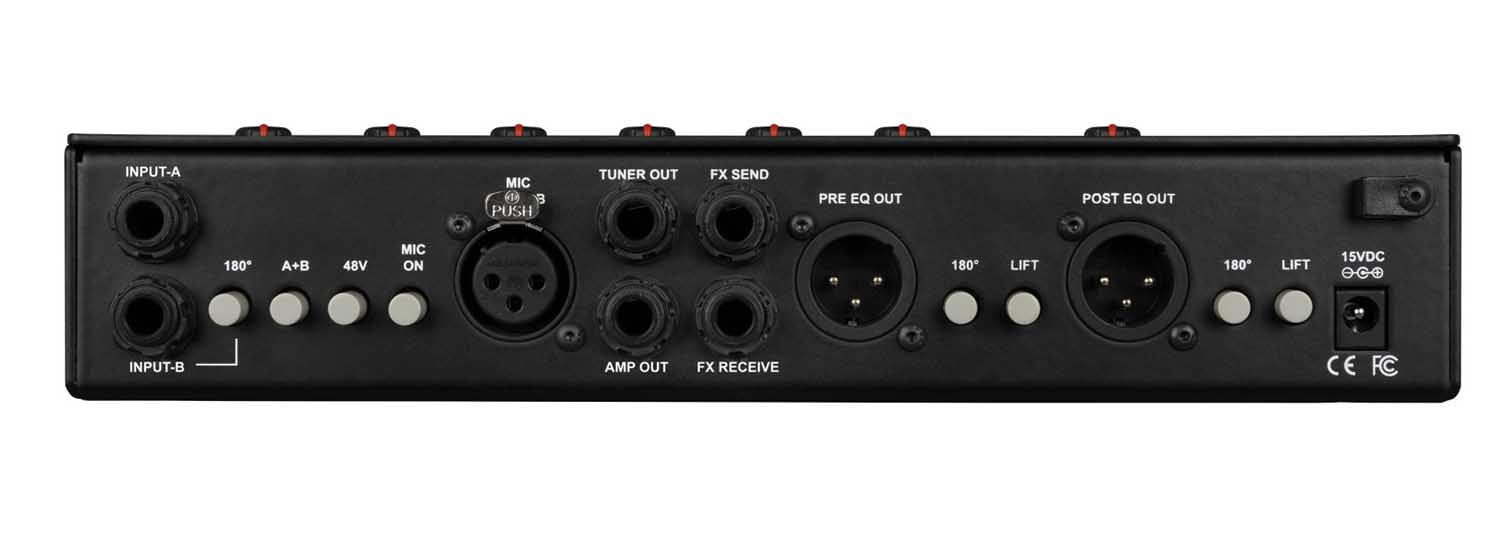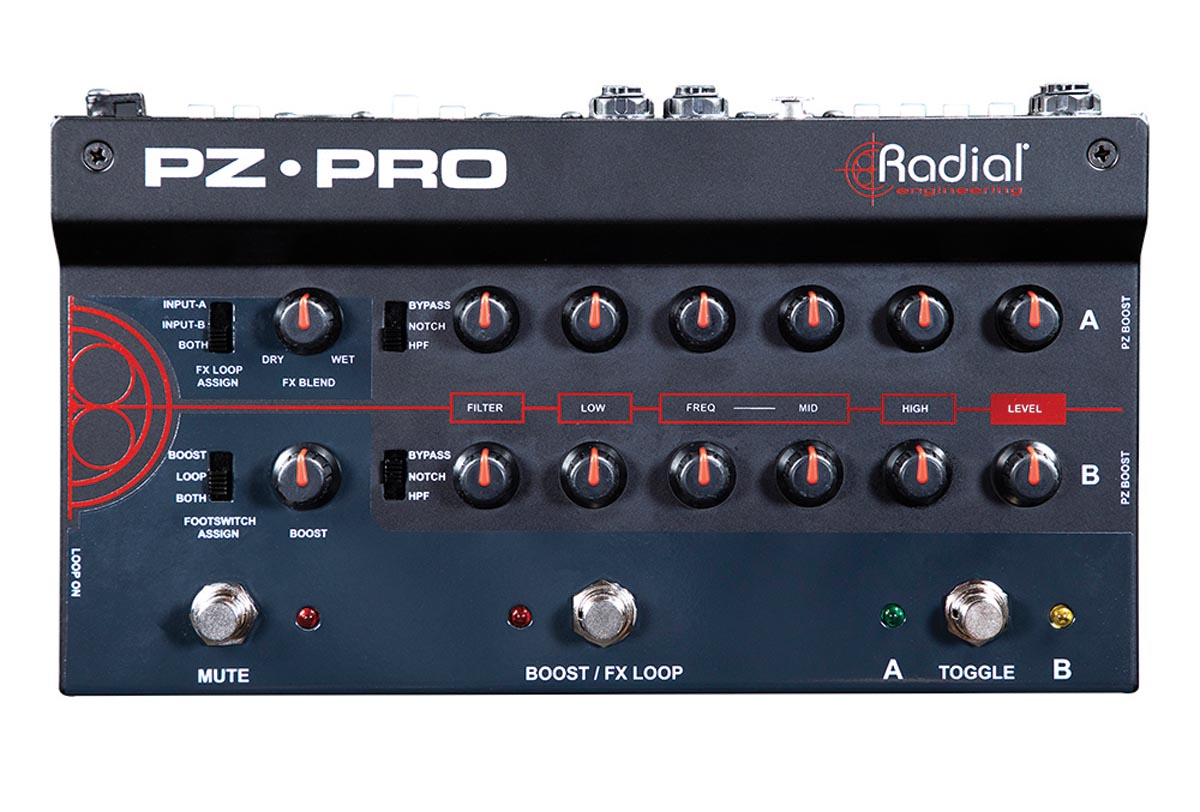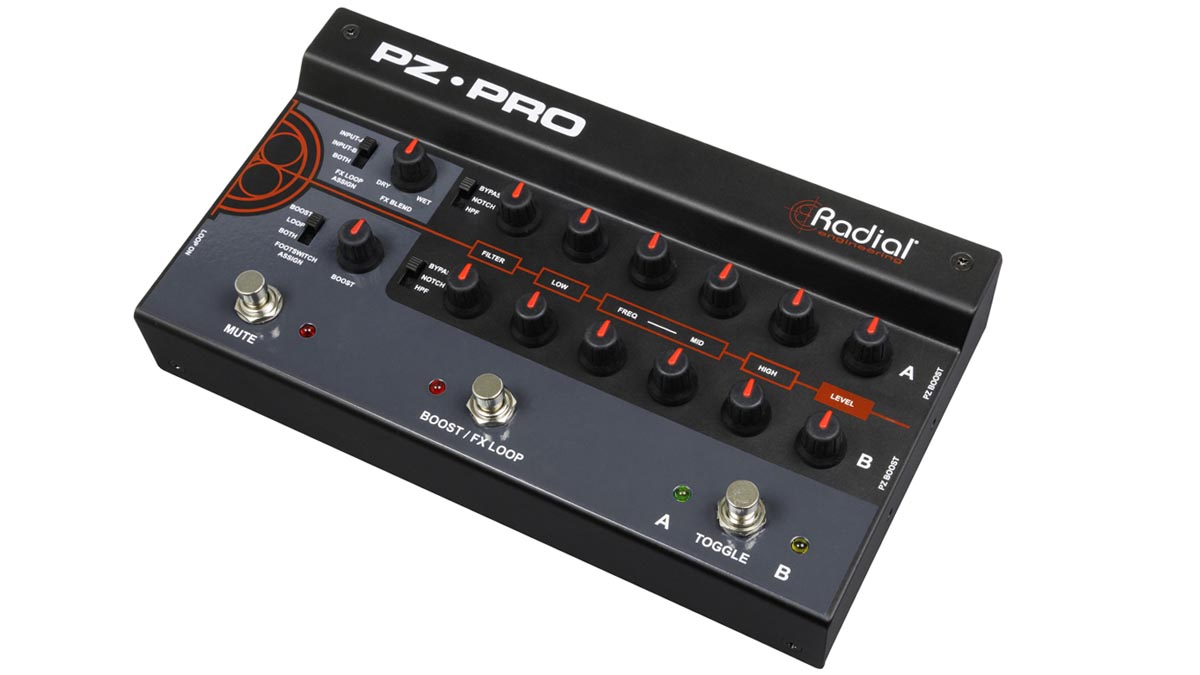GuitarPlayer Verdict
Think of the Radial PZ-Pro as being more than a pedal. It offers musical warmth and a hi-fi quality to your acoustic tone, with a formidable EQ section and all the functionality and connections you could need.
Pros
- +
Velvet tone with no noise.
- +
Simple interface controls deep functionality.
- +
Flexible I/O.
Cons
- -
None.
You can trust Guitar Player.
Radial is renowned for its direct boxes and preamps, and now the company has given its entire Acoustic Series lineup a cosmetic redesign to match its sleek new flagship model, the PZ-Pro.
The acoustic preamp offers two channels with independent EQ, an XLR input option on channel B, and an effects loop assignable to either or both, plus a bevy of handy features for acoustic guitar enthusiasts, including a clean boost with adjustable level control.
The PZ-Pro’s core sound is warm and smooth, like a high-fidelity studio mixing board. Rather than adding a ton of color, it provides a high-definition platform for the instrument’s true sound to shine through
Together, these features allow you to optimize levels and tones for two input sources, making it easy to alternate between or blend them. According to product manager Jay Porter, the PZ legend originated with a prototype sent to James Taylor, who had just finished recording an album.
He reportedly dug the sound of that original PZ-Pre so much that he went back and re-tracked the entire record. Radial’s PZ preamp production line now includes the PZ-Pre, PZ-Deluxe, and this ultimate incarnation.
I always bring at least two guitars to a gig, so it was exciting to do one with the PZ-Pro in tow. Pro is the operative word. Having this pedal made everything come across more smoothly, from the sound itself to the transition between tunings and instruments.

I brought two very different Taylor guitars: an older 514ce and a new Builder’s Edition 816ce. I also had a chain of L.R. Baggs Align effects pedals, a Boss tuner, an AER Compact 60/3 TE, and a Baggs Synapse Personal P.A. I sent the 514 through channel A and the 816 through channel B.
The amp output ran to the AER while the XLR out went to the P.A., and the gig was quickly underway. I appreciated the PZ-Pro’s sturdy construction and straightforward layout.
All the surface controls are old-fashioned knobs and switches that are well labeled and easy to understand. Inputs and outputs are all on the back panel, so I was able to keep my cabling tidy and place the other pedals and expression controls in ideal locations.
The simple pleasure of seamlessly switching back and forth between guitars felt wonderful and made me think that perhaps next time I’ll add something else to the mix. The PZ-Pro can accommodate a variety of acoustic instruments, and the recessed impedance boost button on the side is ideal for those with traditional low-output piezo pickups.
The XLR input with phantom power on channel B is designed to accommodate clip-on condenser mics, which are popular with banjo and mandolin players. The PZ-Pro’s core sound is warm and smooth, like a high-fidelity studio mixing board. Rather than adding a ton of color, it provides a high-definition platform for the instrument’s true sound to shine through.
Radial Engineering’s PZ-Pro is more of an acoustic command center than a simple pedal
The next level of tone is available via excellent equalization, and small adjustments to the high, low, and mid controls work wonders. Practically every acoustic instrument has some weird midrange honk that needs to be rooted out, and the freq knob makes it easy to home in on offending frequencies.
I had the smaller 514ce Grand Auditorium in an open lowered tuning, so dialing in its midrange was very different from the larger 816ce Grand Symphony, which was tuned standard.

The ability to set the overall filter as a notch or high-pass, or to bypass it altogether, is another boon. For example, the old-school Fishman Prefix preamp on the 514ce has its own notch filter, so I used the PZ-Pro’s as a high-pass to eliminate low rumble. Meanwhile, the ES2 system on the Taylor 816ce doesn’t have a notch filter, so I used the PZ-Pro as a notch on that channel.
The 514ce has a Seymour Duncan Active Mag installed in the sound hole as well, so if it were the only instrument on the gig I would have utilized the sum function to activate both channels simultaneously, using one set of controls for the Duncan and the other for the Fishman. It’s always nice to have options.
I encourage any acoustic player with multiple instruments or dual input sources to give the PZ-Pro an audition. Radial’s new flagship preamp/direct box certainly raised the level of my gig
Radial Engineering’s PZ-Pro is more of an acoustic command center than a simple pedal. Serious players will appreciate all that it has to offer in sonic quality, connectablity, and flexibility, as well as its roadworthy construction. If you’ve ever wondered how an elite artist gets a superior acoustic-electric sound, it often starts with a quality preamp.
I encourage any acoustic player with multiple instruments or dual input sources to give the PZ-Pro an audition. Radial’s new flagship preamp/direct box certainly raised the level of my gig and made me feel more like a pro, which makes it worthy of an Editors’ Pick
Specifications
- PRICE: $499 street
- CHANNELS: 2, with independent control knobs: level, high, mid, mid-freq, low, filter with bypass/notch/HPF switch
- FOOTSWITCHES: Mute, boost/FX loop, toggle A/B, all with LED indicator lights
- CONTROLS: FX loop assign switch (input A/B/both); foot switch assign switch (boost/loop/both); loop on side-access switch, PZ boost recessed side-access switch activates +10db and 10 megΩ impedance for piezo transducers
- I/O & FUNCTIONS: ¼-inch input A; ¼-inch input B with 180˚ reverse button, A+B sum button, 48V phantom power button and mic-on button; XLR mic input B; ¼-inch tuner out, amp out, FX send, FX receive; pre EQ XLR out with 180˚ polarity reverse and lift buttons; post EQ XLR out with 180˚ polarity reverse and lift buttons; 15V DC adapter jack
- WEIGHT: 4 lbs
- BUILT: Canada
- CONTACT: Radial Engineering
Jimmy Leslie has been Frets editor since 2016. See many Guitar Player- and Frets-related videos on his YouTube channel, and learn about his acoustic/electric rock group at spirithustler.com.
"The only thing missing is the noise from the tape loop." We review the Strymon EC-1 Single Head dTape Echo, a convincing take on a very special vintage tube Echoplex
"BigSky MX will be replacing the BigSky as my go-to reverb pedal. I’ve heard nothing that covers all the bases with such pristine and detailed audio quality." We crowned the Strymon BigSky MX the champ of multi-reverb pedals











